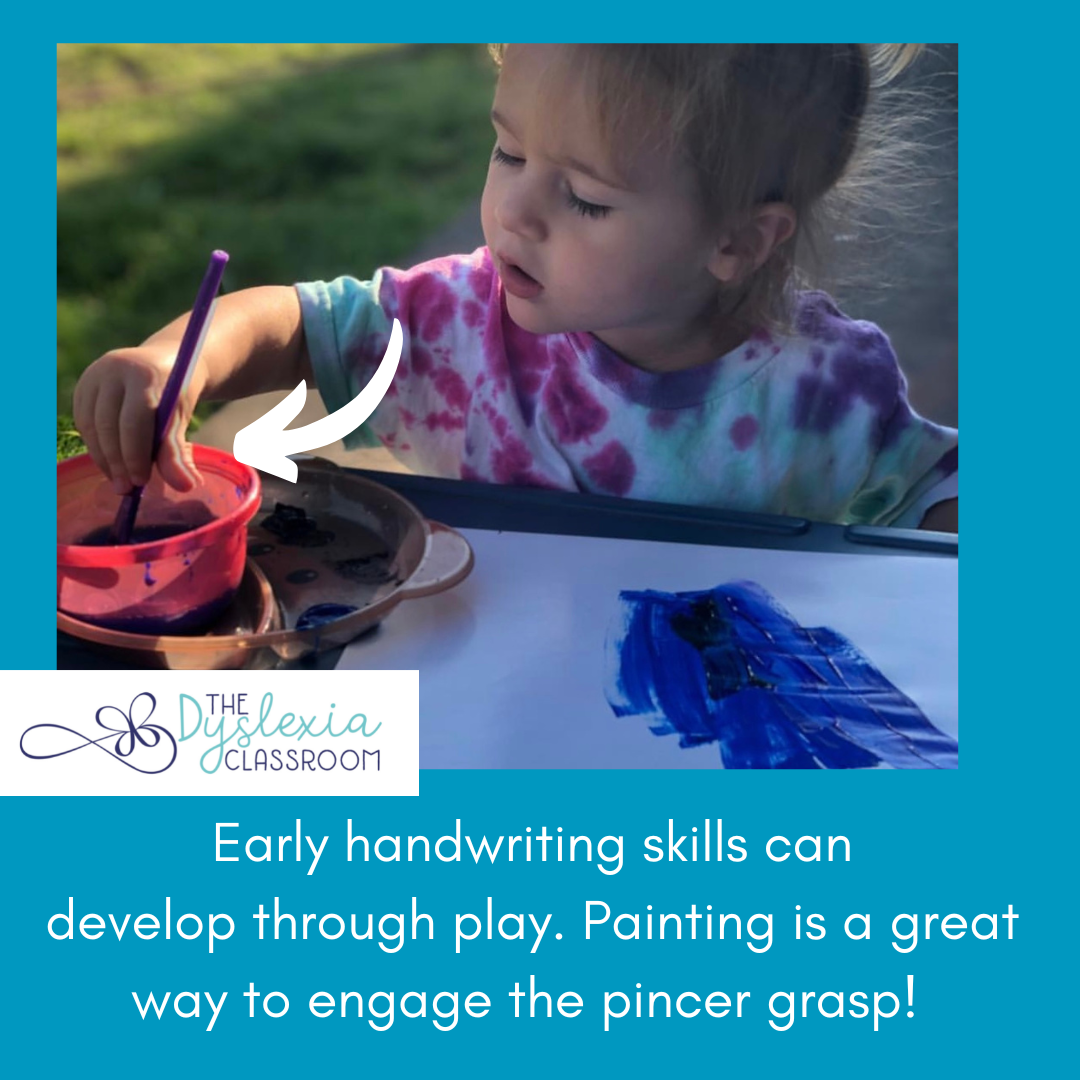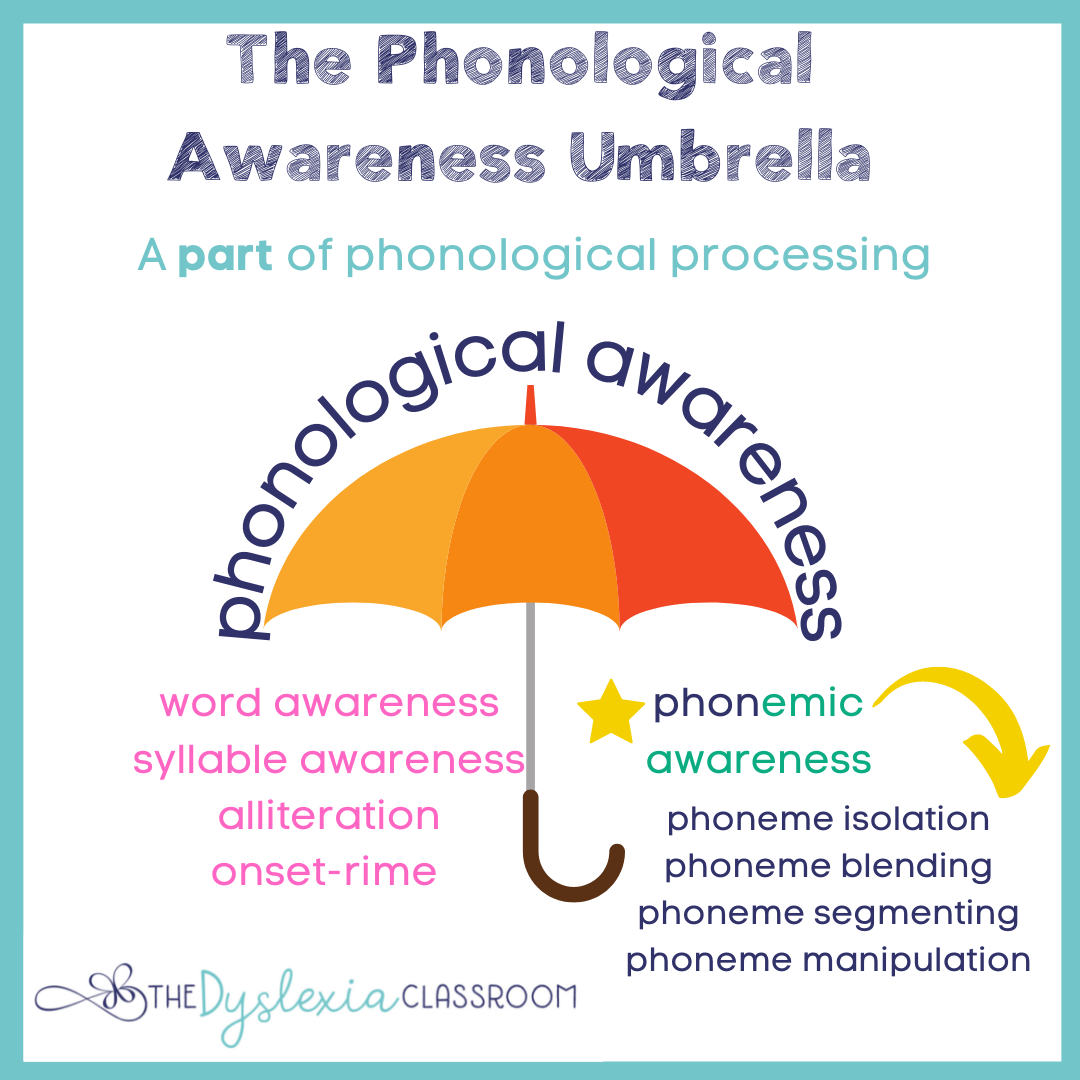Simple Ways to Build Fine Motor Skills with Children

While we think of handwriting skills in school-age children, early development plays a role in children gaining pencil control. There is so much we can do to build those early writing skills before children pick up a pencil!
Developing large and fine motor skills is the basis for handwriting skills and the proper instruction. Often when working with older or early elementary students who struggle with handwriting, I will embed some work with fine motor skills.

How Children Use A Pencil
To hold a pencil correctly, a child must have control of hand muscles, especially the pincer grasp. If you look closely at the grip this little two-year-old uses to hold her paintbrush, you can see her use of the pointer finger and her thumb (pincer grasp) to hold the brush. Her pincer grasp is developed enough for her to move toward the five-finger pencil grasp and eventually to the three-finger pencil grasp used for writing. It is important to note that there are stages of development for pencil...
Why You Should Analyze Your ABC Chart

When we think of classrooms, we almost always envision an alphabet with pictures posted somewhere in the room. We may not realize that the keywords or images used in alphabet posters and books matter - a lot more than you may think! Many cute and colorful alphabet posters are available, and we may gravitate toward what is aesthetically pleasing, but these are not the best choices for our students and classrooms.
Analyzing Our ABC Charts - Why It Matters
Reading is the ability to connect spoken sounds to their letter representations. We want students to elicit the smallest unit of spoken sound, or phoneme, in its purest form. For this reason, being mindful of keywords is essential.
What does this mean? The ability to segment phonemes (sounds) into their smallest units and then blend those sounds into words is what is needed to read and spell. Keywords or pictures we choose to link to graphemes (letter/s) need to connect directly to the individual phoneme (sound).
In English, soun...
Learning Through Sand Play
This is part 2 of the Learning At The Beach series. Click HERE to read part 1.
We made it back home from our fun-filled week at the beach with buckets of shells and happy hearts. 🌊 While it was a week full of fun, we also snuck in some learning. Last week, I shared how we played activities like "Beat the Wave" and "Sandy Sound Dictation." This week, I'm sharing some more activities that we played in the sand as part 2 of the mini-series, Learning at the beach.
One of the powerful reminders for us as parents and educators is that it is possible to play with a purpose. Playful learning can set the stage for enjoyable interactions, reduce the stress sometimes associated with reading, and engage students in reading tasks while still focusing on a learning objective. Here are some additional games/activities that we played at the beach. Whether you are headed to the beach this summer or spending it at home or elsewhere, you can certainly bring these activities into your day.
Learning...
Ways to Learn at the Beach
Each year to kick off summer break, I take my three little girls to the beach. They can spend hours playing in the waves and running along the sandy shores. This year they have tackled boogie-boarding, and I foresee some surf lessons in the future!
As a mom and teacher, I am always looking to weave playful learning into our day. Our beach week is no exception! My girls love to play little reading games in the sand. I keep them short and sweet, which keeps them engaged and playful. We played so many different games that I may need to break it up into a 2-part blog post!
Here are just a few of our favorites to play to review and practice some of our reading skills.
- Letter writing in the sand. I have found that students of all ages love to play with sand. Sand provides kinesthetic practice for pre-writing letter formation and letter practice. The drag, or pull, in the sand helps build connections for the learner through what we refer to as multisensory practice or when we are enga...
Teaching The Schwa Sound
I am heading off to the beach this week and looking forward to a "less stressed" and relaxing time. You may be asking, what does this have to do with reading instruction?

The English language is stress-timed, and when spoken, there is a natural rhythm and fluidity that aids in comprehension, pronunciation, syntax, and expression. The impact of the stressed and unstressed syllables determines spoken sounds, especially vowels.
Stressed And Unstressed Syllables
Before my therapist training, I had never thought about the impact of stressed and unstressed syllables on spelling, pronunciation, syntax, and meaning. I honestly didn't know that the English language is a stressed-time language or what that meant for instruction. Now, I see that explicitly teaching the concept of stressed and unstressed syllables to my students aids in their decoding, encoding, and comprehension.
A stressed syllable is the part of the word that receives a stronger syllable mark. This is noted by the art...
Tips For Success: Movement and Short Vowels
This week, I'm sharing a short video with quick tips for helping your students remember short vowel sounds.
Clearing Up Short Vowel Sounds with Movement Cues
If you work with early learners or dyslexic learners, you may need a great deal of practice with short vowel sound production. Many children will confuse vowel sounds in phonology work, reading, spelling, and sometimes running speech. This may occur for several different reasons. Some children may find sound discrimination tricky, and others may struggle with recalling the sounds when given a letter representation. Some students may also struggle with phonological processing, have speech sound errors, sound substitutions, omit sounds, add sounds, or distort sounds. If this is the case for your students, keep reading. This week, I'm sharing some tips for teaching short vowel sounds.
Closed syllables, a syllable with one vowel followed by one or more consonants, make up almost half of all syllable types. When we can engage more ...
How Does Scooping Phrases Help Fluency?
Recently, I've gotten a lot of questions about fluency and how to teach scooping. I made this video 👆 to help answer some of your questions and share a tip I have for building scooping skills.
How To Build Fluency
There is also a past blog post, Building Fluency In Our Students, that you might want to read for more information about this. Find it HERE.
Need more support?
Please feel free to contact me or let me know what questions and topics you wish to have answered.

This information is the intellectual property of @2016 The Dyslexia Classroom. Do not use or repurpose without expressed permission from The Dyslexia Classroom. Please give The Dyslexia Classroom an attribution if you use, reference, or quote/paraphrase copyrighted materials. This includes but is not limited to blogs, social media, and resources.
What Is The Vowel Valley?
Individual phoneme production is an integral part of reading and spelling instruction. As educators, we need to be solid in understanding and implementing individual speech sounds. Students need to be able to isolate phonemes to segment. The skill of segmenting is the ability to take apart individual phonemes and sounds within words.
Throughout history, scholars have been fascinated with understanding the production of sounds. This work primarily rested with phoneticians, linguists who specialize in phonics, especially the work of Dr. Daniel Jones.
Professor Daniel Jones's system of Cardinal Vowels is one of his most lasting legacies. His chart, developed in 1917, is still referenced as we work with sounds and articulation. I was so excited when I came across the 4th edition of his book An English Pronouncing Dictionary (1937), in which his Outline of English Phonetics chart shows his system of Cardinal Vowels and the English Vowels.
I will leave the work and descriptions of the c...
How To Build Phonemic Awareness In A Fun Way


How does questioning fit into explicit instruction?
Asking students questions has long been a teaching tool used to assess student knowledge, engage in conversations, and promote comprehension. Research shows that using questions in instruction is more effective than without; however, not all questions are the same. So often, we ask questions at the end of an assignment or lesson to determine student learning outcomes. When asked this way, our primary focus is on comprehension of a lesson or reading assignment, etc., but what if we used questions within our explicit instruction to guide students to learn a new concept?
Can our instruction include a discovery model of a concept while still being explicit instruction?
My answer is yes!
In our Orton-Gillingham approach, we use explicit and thoughtful questions to lead students to discover a concept. We do this in a multisensory way in which students engage in more than one sense at a time (see, hear, feel, move).
"Explicit instruction does not leave anything to chance and does not...



